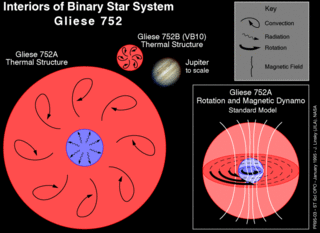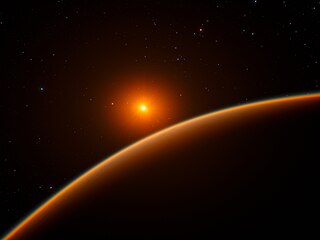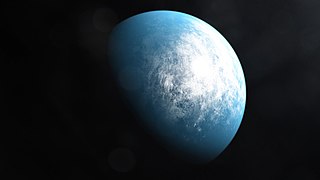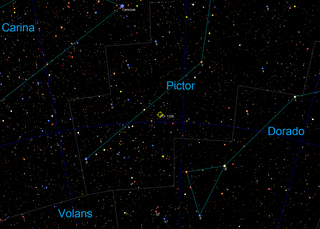
Barnard's Star is a small red dwarf star in the constellation of Ophiuchus. At a distance of 5.96 light-years (1.83 pc) from Earth, it is the fourth-nearest-known individual star to the Sun after the three components of the Alpha Centauri system, and the closest star in the northern celestial hemisphere. Its stellar mass is about 16% of the Sun's, and it has 19% of the Sun's diameter. Despite its proximity, the star has a dim apparent visual magnitude of +9.5 and is invisible to the unaided eye; it is much brighter in the infrared than in visible light.

Lalande 21185 is a star in the south of Ursa Major. It is the apparent brightest red dwarf in the northern hemisphere. Despite this, and being relatively close by, it is very dim, being only magnitude 7.5 in visible light and thus too faint to be seen with the unaided eye. The star is visible through a small telescope or binoculars.

Transiting Exoplanet Survey Satellite is a space telescope for NASA's Explorer program, designed to search for exoplanets using the transit method in an area 400 times larger than that covered by the Kepler mission. It was launched on 18 April 2018, atop a Falcon 9 launch vehicle and was placed into a highly elliptical 13.70-day orbit around the Earth. The first light image from TESS was taken on 7 August 2018, and released publicly on 17 September 2018.

Gliese 752 is a binary star system in the Aquila constellation. This system is relatively nearby, at a distance of 19.3 light-years.

An exoplanet is a planet located outside the Solar System. The first evidence of an exoplanet was noted as early as 1917, but was not recognized as such until 2016; no planet discovery has yet come from that evidence. What turned out to be the first detection of an exoplanet was published among a list of possible candidates in 1988, though not confirmed until 2003. The first confirmed detection came in 1992, with the discovery of terrestrial-mass planets orbiting the pulsar PSR B1257+12. The first confirmation of an exoplanet orbiting a main-sequence star was made in 1995, when a giant planet was found in a four-day orbit around the nearby star 51 Pegasi. Some exoplanets have been imaged directly by telescopes, but the vast majority have been detected through indirect methods, such as the transit method and the radial-velocity method. As of 1 January 2024, there are 5,576 confirmed exoplanets in 4,113 planetary systems, with 887 systems having more than one planet. This is a list of the most notable discoveries.

Planet Hunters is a citizen science project to find exoplanets using human eyes. It does this by having users analyze data from the NASA Kepler space telescope and the NASA Transiting Exoplanet Survey Satellite. It was launched by a team led by Debra Fischer at Yale University, as part of the Zooniverse project.

The Next-Generation Transit Survey (NGTS) is a ground-based robotic search for exoplanets. The facility is located at Paranal Observatory in the Atacama desert in northern Chile, about 2 km from ESO's Very Large Telescope and 0.5 km from the VISTA Survey Telescope. Science operations began in early 2015. The astronomical survey is managed by a consortium of seven European universities and other academic institutions from Chile, Germany, Switzerland, and the United Kingdom. Prototypes of the array were tested in 2009 and 2010 on La Palma, and from 2012 to 2014 at Geneva Observatory.

LHS 1140 b is an exoplanet orbiting within the conservative habitable zone of the red dwarf LHS 1140. Discovered in 2017 by the MEarth Project, LHS 1140 b is about 5.6 times the mass of Earth and about 70% larger in radius, putting it within the super-Earth category of planets. It was initially thought to be a dense rocky planet, but refined measurements of its mass and radius have found a lower density, indicating that it is likely an ocean world with 9-19% of its mass composed of water, or a dense mini-Neptune. LHS 1140 b orbits entirely within the star's habitable zone and gets 43% the incident flux of Earth. The planet is 49 light-years away and transits its star, making it an excellent candidate for atmospheric studies with ground-based and/or space telescopes.
TOI-700 is a red dwarf 101.4 light-years away from Earth located in the Dorado constellation that hosts TOI-700 d, the first Earth-sized exoplanet in the habitable zone discovered by the Transiting Exoplanet Survey Satellite (TESS).

TOI-700 d is a near-Earth-sized exoplanet, likely rocky, orbiting within the habitable zone of the red dwarf TOI-700, the outermost planet within the system. It is located roughly 101.4 light-years (31.1 pc) away from Earth in the constellation of Dorado. The exoplanet is the first Earth-sized exoplanet in the habitable zone discovered by the Transiting Exoplanet Survey Satellite (TESS).

TOI-1338 is a binary star system located in the constellation Pictor, about 1,320 light-years from Earth. It is orbited by two known circumbinary planets, TOI-1338 b, discovered by the Transiting Exoplanet Survey Satellite (TESS) and BEBOP-1c, discovered by the Binaries Escorted By Orbiting Planets project.
LTT 3780, also known as TOI-732 or LP 729-54, is the brighter component of a wide visual binary star system in the constellation Hydra. This star is host to a pair of orbiting exoplanets. Based on parallax measurements, it is located at a distance of 72 light years from the Sun. LTT 3780 has an apparent visual magnitude of 13.07, requiring a telescope to view.
TOI-561 is an old, metal-poor, Sun-like star, known to have multiple small planets. It is an orange dwarf, estimated to be 10.5 billion years old, and about 79% the mass and 85% the radius of Sol, Earth's sun.
L 98-59 is a bright M dwarf star, located in the constellation of Volans, at a distance of 10.608 parsecs, as measured by Gaia.
TOI-1452 b is a confirmed super-Earth exoplanet, possibly a water world, orbiting a red-dwarf star TOI-1452 about 100 light-years away in the Draco constellation. The exoplanet is about 70% larger in diameter than Earth, and roughly five times as massive.
L 168-9 is a red dwarf star located 82.1 light-years away from the Solar System in the constellation of Tucana. The star has about 62% the mass and 60% the radius of the Sun. It has a temperature of 3,800 K and a rotation period of 29.8 days. L 168-9 is orbited by one known exoplanet.

TOI-700 e is the second outermost exoplanet orbiting TOI-700, a red dwarf star in the constellation of Dorado.










